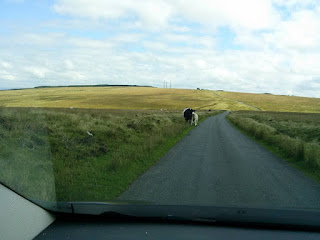We stopped for coffee at Aberaeron (aber means mouth of a river), and while we sat drinking our oh-so-welcome hot drink on this chilly morning, we got into conversation with two gentlemen who were doing the same thing. They too were on holiday, visiting from Cornwall. The younger man, Steven, told us about his youth growing up by the sea. "There was a big rock, about a half mile out from shore, that we would swim or boat out to. We'd dive off the rock into the water, and when the tide went out, we'd explore the caves under it and also the ones along the shore. We were mad! We would dive off the high cliffs there along the shore too, never thought a thing about the danger. Young and fearless, we were."
His father told us that he had been a tin miner in Cornwall until the mines closed. I asked him, "What does tin ore look like?"
 |
| Larry and the tin miner. It sounds like the conditions of the miners in Cornwall were very much like those of West Virginia coal miners. |
He thought a moment, and then said, "Coal. It looks like coal, black like that, but with what look like crystals." I did a search when I got home, and found this picture of tin ore on Wikipedia. "Black tin" is the name for tin mined in Devon, England and in Cornwall.
 |
| https://en.wikipedia.org/wiki/Black_tin |
I found this old postcard image of a Welsh tin mine also on Wikipedia. Later we would see some of the old workings on our travels.
Too soon, we said goodbye to our new friends, and left the sea behind us.
We were soon back in the green hills.
Seriously! You know we had to look.
In the end I settled for a couple books, this gorgeous Welsh wool jacket which fit perfectly,
and these two copper and brass vases that must have come out of a church.
The road narrowed and I was often questioning the wisdom of the SatNav. The scenery changed to rougher land,
and there were more obstacles...
Soon we wound down from the moor and into the quaint, charming village of Llansawel. We were so craving tea or coffee, but no place was open. Fortunately, however, we discovered a public toilet-these are scattered all over Britain, it seems, and very well marked. Perhaps that is because of the many public footpaths, or perhaps because the national drinks of beer and tea require more frequent need?
It was in the public restroom that I discovered the strange story of the Llansawel Elephant, Lizzie.
I wish my photo of the sign had come out more clearly. I was using my phone because the camera battery was dead once again. The story is that in 1888 a circus came to town with a huge African elephant named Lizzie. For some reason the elephant died while in Llansawel, a great loss to the traveling circus.The owners decided to have her stuffed to recoup some of their money. Apparently the elephant's remains that were removed for this gigantic taxidermy project were buried in the town, under the town hall, or as a recent article claims, under the very place our car was parked. The stuffed elephant was in the Swansea, Wales museum until the 1950's when moth damage required her to be permanently laid to rest. You can read an excellent, detailed article about the elephant of Llansawel by clicking here.
Eventually we found ourselves back on a two-lane highway, and into the mountains and the park known as the Brecon Beacons.
 |
| At last, our destination on a sign! |
And then we were in Merthyr Tydfil, and found our b&b, as promised, "as high up as you can go until the road runs out."
Copyright Susanna Holstein. All rights reserved. No Republication or Redistribution Allowed without attribution to Susanna Holstein.






















No comments:
Post a Comment
Thank you for sharing your thoughts! Comments are moderated so may not appear immediately, but be assured that I read and enjoy each and every word you write, and will post them as quickly as possible.